Abstract
The kaurene synthetase from immature seeds of Marah macrocarpus (Greene) Greene was partially purified from cell-free homogenates of endosperm by a combination of QAE-Sephadex A-25 chromatography and hydroxyapatite chromatography and freed of contaminating phosphatase activity. The two catalytic activities associated with kaurene synthetase, the cyclization of geranylgeranyl-pyrophosphate to copalyl-pyrophosphate (activity A) and the cyclization of copalyl-pyrophosphate to ent-kaurene (activity B), were not even partially resolved from one another during these procedures. Both activities had identical elution profiles from a calibrated Sepharose 4B column corresponding to a molecular weight less than that of ovalbumin (45,000).
The A and B activities had pH optima of 7.3 and 6.9, respectively. Both activities required millimolar concentrations of the following divalent cations in the order: Mg2+ > Mn2+ > Co2+. Activities A and B were both sensitive to inhibition by Hg2+, Cu2+, p-hydroxymercuribenzoate, and N-ethylmaleimide, but activity B was much more sensitive than activity A. The average value of Km′ (apparent Km in the absence of substrate inhibition) for geranylgeranyl-pyrophosphate was 1.6 μm. Values of 0.5 and 0.6 μm were obtained for Km′ and Km, respectively, for copalyl-pyrophosphate. The Vm′ values for the two activities were similar: 12 and 9 pmol/minute·μg protein for activities A and B, respectively.
N,N-Dimethylaminoethyl-2,2-diphenylpentanoate (SKF-525A) and N,N-dimethylaminoethyl-2,2-diphenylphentyl ether (SKF-3301A), tributyl-2,4-dichlorobenzylphosphonium chloride (Phosfon D), tributyl-2,4-dichlorobenzylammonium chloride (Phosfon S), 2′-isopropyl-4′-(trimethylammonium chloride)-5′-methylphenyl piperidine-1-carboxylate (Amo-1618), 2-(N,N-dimethyl-N-heptylammonium bromide)-p-methan-1-ol (Q-58), and 2-(N,N-dimethyl-N-octylammonium bromide)-p-methan-1-ol (Q-64), at concentrations from 1 to 5 μm, were effective inhibitors of kaurene synthetase activity A. Acetylcholine chloride and 2-chloroethyl-trimethylammonium chloride were effective inhibitors of activity A only at concentrations of 5 mm or greater. Abscisic acid, indole-3-acetate, gibberellin A1, gibberellin A3, a mixture of gibberellins A4 and A7, gibberellin A13, and N,N-dimethylaminosuccinamic acid (B995) were not inhibitory at any of the levels tested. None of these compounds was an effective inhibitor of activity B at concentrations less than 0.5 mm.
Full text
PDF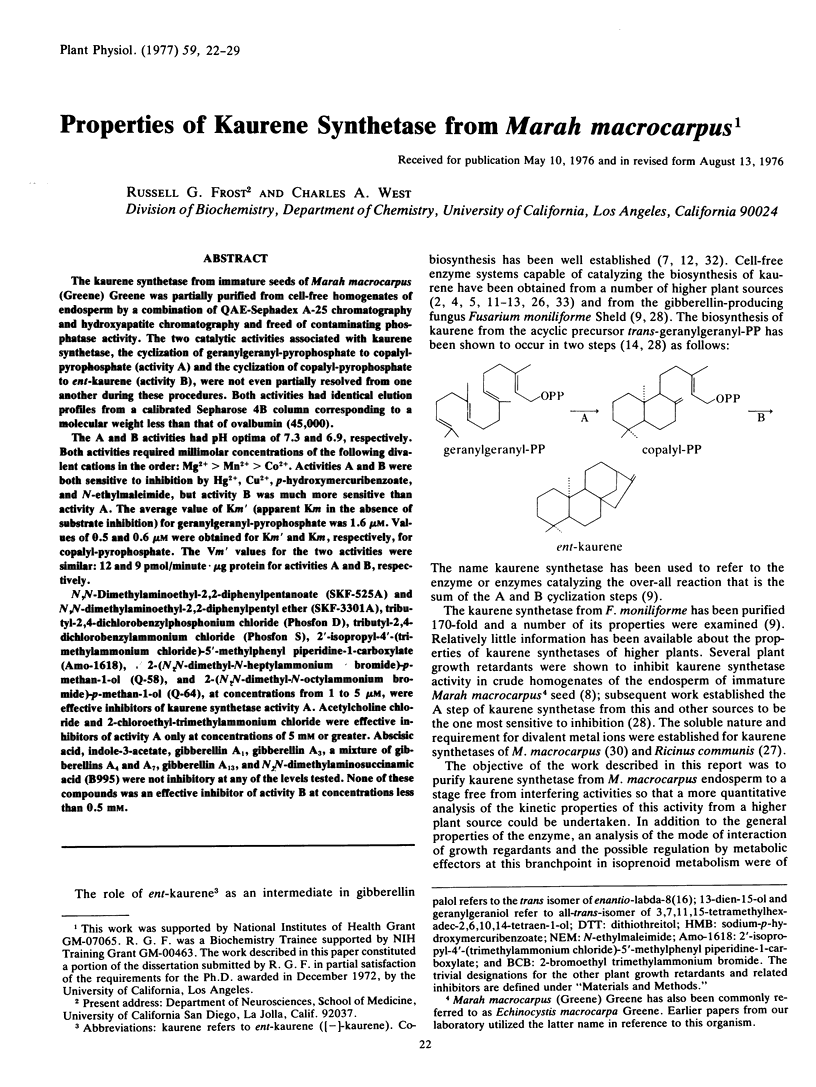


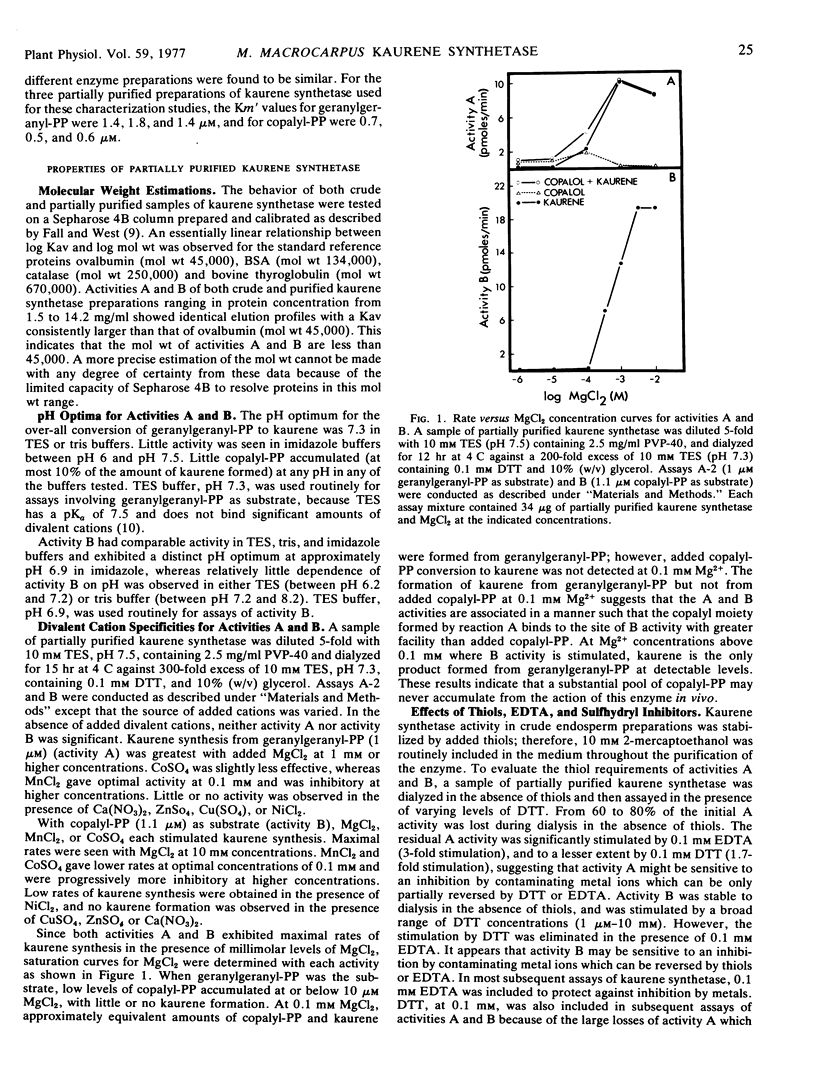
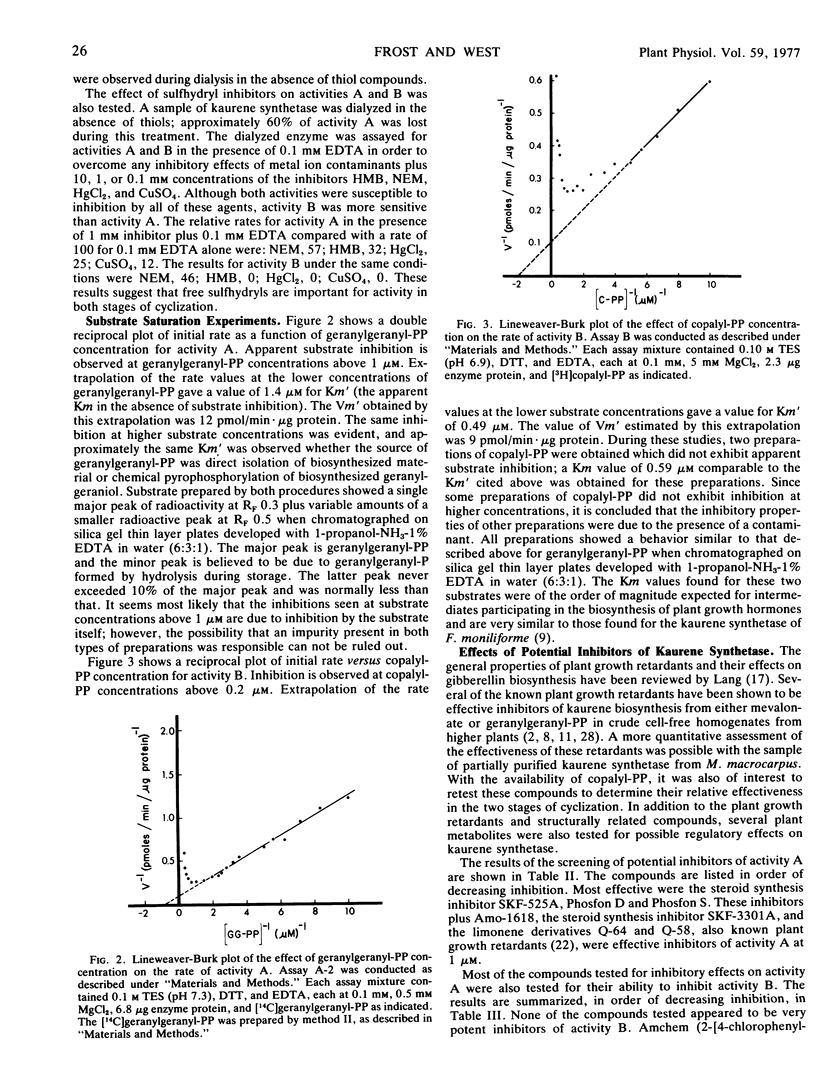
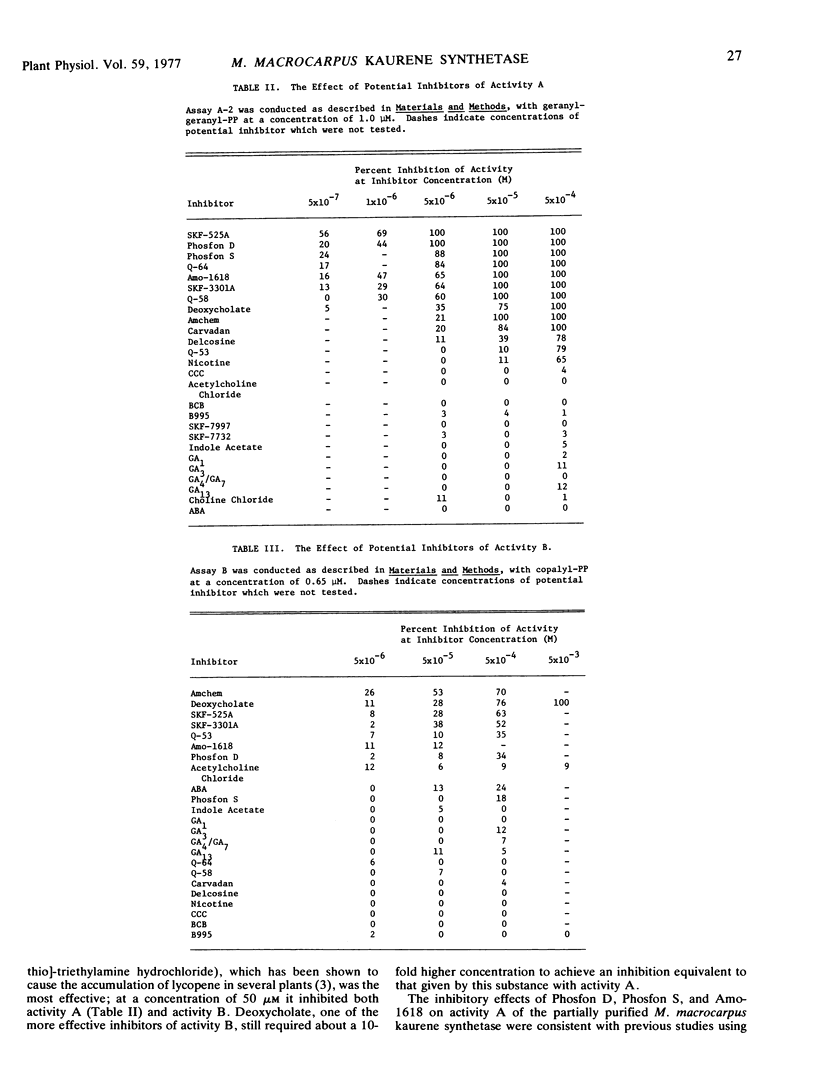
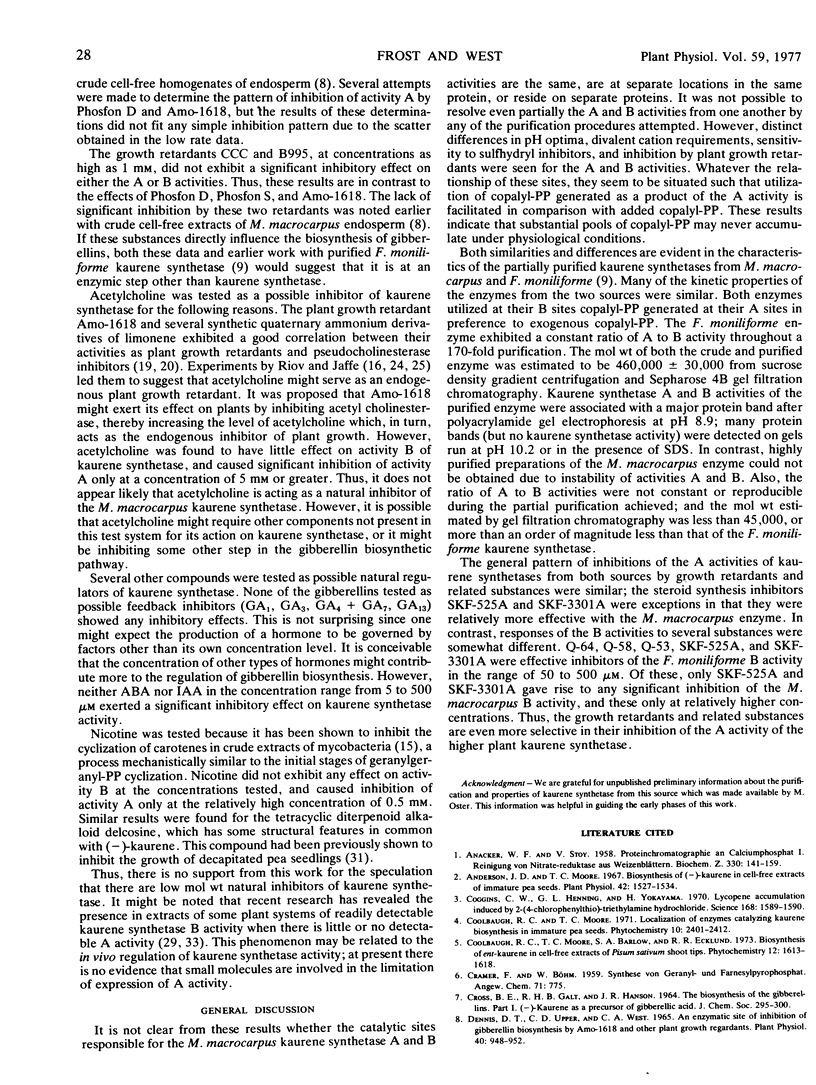

Selected References
These references are in PubMed. This may not be the complete list of references from this article.
- ANACKER W. F., STOY V. Proteinchromatogrphie an Calciumphosphat. I. Reinigung von Nitrat-reduktase aus Weizenblättern. Biochem Z. 1958;330(2):141–159. [PubMed] [Google Scholar]
- Anderson J. D., Moore T. C. Biosynthesis of (-)-Kaurene in Cell-free Extracts of Immature Pea Seeds. Plant Physiol. 1967 Nov;42(11):1527–1534. doi: 10.1104/pp.42.11.1527. [DOI] [PMC free article] [PubMed] [Google Scholar]
- Coggins C. W., Jr, Henning G. L., Yokoyama H. Lycopene accumulation induced by 2-(4-chlorophenylthio)-triethylamine hydrochloride. Science. 1970 Jun 26;168(3939):1589–1590. doi: 10.1126/science.168.3939.1589. [DOI] [PubMed] [Google Scholar]
- Dennis D. T., Upper C. D., West C. A. An enzymic site of inhibition of gibberellin biosynthesis by Amo 1618 and other plant growth retardants. Plant Physiol. 1965 Sep;40(5):948–952. doi: 10.1104/pp.40.5.948. [DOI] [PMC free article] [PubMed] [Google Scholar]
- Fall R. R., West C. A. Purification and properties of kaurene synthetase from Fusarium moniliforme. J Biol Chem. 1971 Nov 25;246(22):6913–6928. [PubMed] [Google Scholar]
- GRAEBE J. E., DENNIS D. T., UPPER C. D., WEST C. A. BIOSYNTHESIS OF GIBBERELLINS. I. THE BIOSYNTHESIS OF (-)-KAUREN-19-OL, AND TRANS-GERANYLGERANIOL IN ENDOSPERM NUCELLUS OF ECHINOCYSTIS MACROCARPA GREENE. J Biol Chem. 1965 Apr;240:1847–1854. [PubMed] [Google Scholar]
- Good N. E., Winget G. D., Winter W., Connolly T. N., Izawa S., Singh R. M. Hydrogen ion buffers for biological research. Biochemistry. 1966 Feb;5(2):467–477. doi: 10.1021/bi00866a011. [DOI] [PubMed] [Google Scholar]
- Howes C. D., Batra P. P. Accumulation of lycopene and inhibition of cyclic carotenoids in Mycobacterium in the presence of nicotine. Biochim Biophys Acta. 1970 Oct 27;222(1):174–179. doi: 10.1016/0304-4165(70)90362-4. [DOI] [PubMed] [Google Scholar]
- LOWRY O. H., ROSEBROUGH N. J., FARR A. L., RANDALL R. J. Protein measurement with the Folin phenol reagent. J Biol Chem. 1951 Nov;193(1):265–275. [PubMed] [Google Scholar]
- Oster M. O., West C. A. Biosynthesis of trans-geranylgeranyl pyrophosphate in endosperm of Echinocystis macrocarpa Greene. Arch Biochem Biophys. 1968 Sep 20;127(1):112–123. doi: 10.1016/0003-9861(68)90207-5. [DOI] [PubMed] [Google Scholar]
- POPJAK G., CORNFORTH J. W., CORNFORTH R. H., RYHAGE R., GOODMAN D. S. Studies on the biosynthesis of cholesterol. XVI. Chemical synthesis of 1-H2-3-2-C-14- and 1-D2-2-C-14-trans-trans-farnesyl pyrophosphate and their utilization in squalene biosynthesis. J Biol Chem. 1962 Jan;237:56–61. [PubMed] [Google Scholar]
- Riov J., Jaffe M. J. Cholinesterases from Plant Tissues: II. Inhibition of Bean Cholinesterase by 2-Isopropyl-4-dimethylamino-5-methylphenyl-1-piperidine Carboxylate Methyl Chloride (AMO-1618). Plant Physiol. 1973 Sep;52(3):233–235. doi: 10.1104/pp.52.3.233. [DOI] [PMC free article] [PubMed] [Google Scholar]
- Robinson D. R., West C. A. Biosynthesis of cyclic diterpenes in extracts from seedlings of Ricinus communis L. I. Identification of diterpene hydrocarbons formed from mevalonate. Biochemistry. 1970 Jan 6;9(1):70–79. doi: 10.1021/bi00803a010. [DOI] [PubMed] [Google Scholar]
- Robinson D. R., West C. A. Biosynthesis of cyclic diterpenes in extracts from seedlings of Ricinus communis L. II. Conversion of geranylgeranyl pyrophosphate into diterpene hydrocarbons and partial purification of the cyclization enzymes. Biochemistry. 1970 Jan 6;9(1):80–89. doi: 10.1021/bi00803a011. [DOI] [PubMed] [Google Scholar]
- Shechter I., West C. A. Biosynthesis of gibberellins. IV. Biosynthesis of cyclic diterpenes from trans-geranylgeranyl pyrophosphate. J Biol Chem. 1969 Jun 25;244(12):3200–3209. [PubMed] [Google Scholar]
- Simcox P. D., Dennis D. T., West C. A. Kaurene synthetase from plastids of developing plant tissues. Biochem Biophys Res Commun. 1975 Sep 2;66(1):166–172. doi: 10.1016/s0006-291x(75)80309-3. [DOI] [PubMed] [Google Scholar]
- Upper C. D., West C. A. Biosynthesis of gibberellins. II. Enzymic cyclization of geranylgeranyl pyrophosphate to kaurene. J Biol Chem. 1967 Jul 25;242(14):3285–3292. [PubMed] [Google Scholar]
- Yafin Y., Shechter I. Comparison between Biosynthesis of ent-Kaurene in Germinating Tomato Seeds and Cell Suspension Cultures of Tomato and Tobacco. Plant Physiol. 1975 Nov;56(5):671–675. doi: 10.1104/pp.56.5.671. [DOI] [PMC free article] [PubMed] [Google Scholar]


